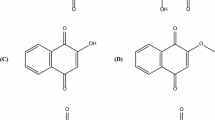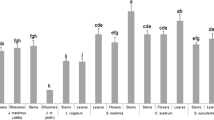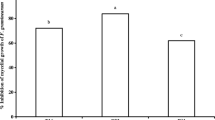Abstract
A number of Penicillium isolates were recovered in association to Rhizoctonia solani strains pathogenic on tobacco and from soil on plates pre-colonized by the pathogen itself. Their antagonism toward R. solaniAG-2-1 was evaluated in dual cultures in vitro. Inhibition of growth was evident to some extent in most pairings, while hyphal interactions referable to mycoparasitic relationships were not observed. However, the occurrence of plasmolysis and/or vacuolisation and the induction of monilioid cells were indicative of the release of bioactive compounds. Therefore, production of fungitoxic metabolites was tested by adding concentrated culture filtrates of each Penicillium isolate to the growth medium of R. solani. Complete and lasting inhibition was incited by culture filtrates of some isolates belonging to P. brevicompactum, P. expansum, and P. pinophilum. Three purified compounds, respectively mycophenolic acid, patulin and 3-O-methylfunicone, which were extracted from culture filtrates, were able to inhibit R. solani in vitro. Their production was also detected in dual cultures of the same Penicilliumstrains with R. solani prepared in sterilized soil and when the Penicilliumstrains were cultured directly on R. solani mycelium harvested from liquid cultures. The possible role of such metabolites in antagonism of the above-mentioned Penicilliumspecies against R. solani is discussed.
Similar content being viewed by others
References
HD Shew TA Melton (1995) ArticleTitleTarget spot of tobacco Plant Dis. 79 6–11
JA Lewis MM Kulik (1996) Introduced biocontrol agents to suppress diseases caused by Rhizoctonia B Sneh S Jabaji-Hare S Neate G Dijst (Eds) Rhizoctonia Species: Taxonomy, Molecular Biology, Ecology, Pathology and Disease Control Kluwer Academic Publishers Dordrecht, the Netherlands 507–514
PHJF Van den Boogert (1996) Mycoparasitism and biocontrol B Sneh S Jabaji-Hare S Neate G Dijst (Eds) Rhizoctonia Species: Taxonomy, Molecular Biology, Ecology, Pathology and Disease Control Kluwer Academic Publishers Dordrecht, the Netherlands 485–493
JI Pitt (1979) The genus Penicillium and its teleomorphic states Eupenicillium and Talaromyces Academic Press New York, USA
JI Pitt (2000) A laboratory guide to common Penicillium species. 3rd edn. CSIRO Division of Food Processing North Ryde, Australia
RA Samson ES Hoekstra JC Frisvad O. Filtenborg (2000) Introduction to food- and airborne fungi. 6th edn. Centraalbureau voor Schimmelcultures Utrecht, the Netherlands
HA Anderson JM Bracewell AR Fraser D Jones GW Robertson JD Russell (1988) ArticleTitle5-Hydroxymaltol and mycophenolic acid, secondary metabolites from Penicillium echinulatum Trans. Brit. Mycol. Soc. 91 649–651
YA Harrison A Stewart (1988) ArticleTitleSelection of fungal antagonists for biological control of onion white rot in New Zealand New Zeal. J. Exp. Agr. 16 249–256
PD Kharbanda JS Dahiya (1990) ArticleTitleA metabolite of Penicillium verrucosum inhibitory to growth of Leptosphaeria maculans and Rhizoctonia solani Can. J. Plant Pathol. 12 335
HA Melouk CN Akem (1987) ArticleTitleInhibition of growth of Sclerotinia minor and other pathogens by citrinin in the filtrate of Penicillium citrinum Mycopathologia 100 91–96 Occurrence Handle10.1007/BF00467100
B Proksa J Adamcova J Fuska (1992) ArticleTitle2-Methylsorbic acid, an antifungal metabolite of P. vermiculatum Appl. Microbiol. and Biotechnol. 37 442–445
A Vey RE Hoagland TM Butt (2001) Toxic metabolites of fungal biocontrol agents TM Butt C Jackson N Magan (Eds) Fungi as Biocontrol Agents CAB International Wallingford, England 311–346
C Alagesaboopathi (1994) ArticleTitleBiological control of damping-off disease of cotton seedling Curr. Sci. 66 865–868
MG Boosalis (1956) ArticleTitleEffect of soil temperature and green manure amendment of unsterilized soil on parasitism of Rhizoctonia solani by Penicillium vermiculatum and Trichoderma sp. Phytopathology 46 473–478
S De Stefano R Nicoletti A Milone S Zambardino (1999) ArticleTitle3-O-Methylfunicone, a fungitoxic metabolite produced by the fungus Penicillium pinophilum Phytochemistry 52 1399–1401 Occurrence Handle10.1016/S0031-9422(99)00320-9
DFC Mulligan JW Deacon (1992) ArticleTitleDetection of presumptive mycoparasites in soil placed on host-colonized agar plates Mycol. Res. 96 605–608
R Nicoletti D Blancard B Cailleteau (1998) ArticleTitleCaractérisation et étude du puvoir pathogène de 5 isolats français de Rhizoctonia inféodés au tabac Annales du Tabac, Section 2 30 24–29
R Nicoletti E Lahoz S Kanematsu S Naito R Contillo (1999) ArticleTitleCharacterization of Rhizoctonia solani isolates from tobacco fields related to anastomosis groups 2-1 and BI (AG 2-1 and AG BI) J. Phytopathol. 197 71–77 Occurrence Handle10.1046/j.1439-0434.1999.147002071.x
KH Domsch W Gams TH Anderson (1980) Compendium of soil fungi Academic Press New York, USA
JC Frisvad (1981) ArticleTitlePhysiological criteria and mycotoxin production as aids in identification of common asymmetric Penicillia Appl. Environ. Microbiol. 41 568–579
W Gams (1993) Supplement and corrigendum to the compendium of soil fungi IHW-Verlag Eching, Germany
AC Stolk RA Samson JC Frisvad O Filtenborg (1990) The systematics of the terverticillate Penicillia RA Samson JI Pitt (Eds) Modern Concepts in Penicillium and Aspergillus Classification Plenum Press New York, USA 121–137
PM Scott (1974) Patulin LFH Purchase (Eds) Mycotoxins Elsevier Scientific Publishing Company Amsterdam, the Netherlands 383–403
RL Danheiser SK Gee JL Perez (1986) ArticleTitleTotal synthesis of mycophenolic acid J. Amer. Chem. Soc. 108 806–810 Occurrence Handle10.1021/ja00264a038
P Jeffries TWK Young (1994) Interfungal parasitic relationships CAB International Wallingford, England
HL Barnett FL Binder (1973) ArticleTitleThe fungal host-parasite relationship Ann. Rev. of Phytopathol. 11 273–292 Occurrence Handle10.1146/annurev.py.11.090173.001421
PHJF Van den Boogert JW Deacon (1994) ArticleTitleBiotrophic mycoparasitism by Verticillium biguttatum on Rhizoctonia solani Eur. J. Plant Pathol. 100 137–156 Occurrence Handle10.1007/BF01876247
GC Papavizas RD Lumsden (1980) ArticleTitleBiological control of soilborne fungal propagules Ann. Rev. Phytopathol. 18 389–413 Occurrence Handle10.1146/annurev.py.18.090180.002133
K Sivasithamparam EL Ghisalberti (1998) Secondary metabolism in Trichoderma and Gliocladium CP Kubicek G Harman (Eds) Trichoderma and Gliocladium. Basic biology, taxonomy and genetics Taylor & Francis London, England 139–191
A Stammati R Nicoletti S De Stefano F Zampaglioni F Zucco (2002) ArticleTitleCytostatic properties of a novel compound derived from Penicillium pinophilum: An in vitro study Altern. Lab. Anim. 30 1–7 Occurrence Handle11827566
B Andersen (1991) ArticleTitleConsistent production of phenolic compounds by Penicillium brevicompactum for chemotaxonomic characterization Antonie van Leeuwenhoek 60 115–123 Occurrence Handle10.1007/BF00572701 Occurrence Handle1842913
P Lafont JP Debeaupuis M Gaillardin J Payen (1979) ArticleTitleProduction of mycophenolic acid by Penicillium roqueforti strains Appl. Environ. Microbiol. 37 365–368 Occurrence Handle453818
JC Frisvad O Filtenborg (1989) ArticleTitleTerverticillate Penicillia: Chemotaxonomy and mycotoxin production Mycologia 81 837–861
TO Larsen H Franzyk SR Jensen (1999) ArticleTitleUV-guided isolation of verrucins A and B, novel quinazolines from Penicillium verrucosum structurally related to anacine from Penicillium aurantiogriseum J. Nat. Prod. 62 1578–1580 Occurrence Handle10.1021/np990251p Occurrence Handle10579880
CR Howell RD Stipanovic (1983) ArticleTitleGliovirin, a new antibiotic from Gliocladium virens, and its role in the biological control of Pythium ultimum Can. J. Microbiol. 29 321–324
Author information
Authors and Affiliations
Corresponding author
Rights and permissions
About this article
Cite this article
Nicoletti, R., De Stefano, M., De Stefano, S. et al. Antagonism against Rhizoctonia solani and fungitoxic metabolite production by some Penicillium isolates. Mycopathologia 158, 465–474 (2004). https://doi.org/10.1007/s11046-004-3712-5
Received:
Accepted:
Issue Date:
DOI: https://doi.org/10.1007/s11046-004-3712-5




